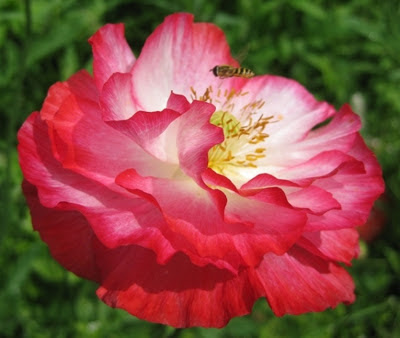A Lesson Plan for Gardening in the Classroom in Alaska, by Jessica Mulvey, an Alaska Master Gardener
“If the bee disappears from the surface of the Earth, man
would have no more than four years left to live.” ….
The above quote has been falsely been attributed to Albert Einstein but is the spirit of the quote true? Pollinators, bees particularly, have been in the news over the past decade due to dramatic & devastating population declines. Debates over pesticides and their effects on pollinators are currently being heard in the halls of our nation’s government. Clearly pollinators are all the buzz! What are pollinators? Why are they so important? History & science have shown us that honey bees did not exist in the Western hemisphere before European expansion in the 15th century. How were plants pollinated before that? Should honey bees be considered an ‘invasive species’? Should WE?
 |
| A Flower Fly (Diptera: Syrphidae) hovers over a Pink Poppy. Photo by Heidi Rader. |
Subject Area: Social Studies
Grade Level:11-12
Ideal season for Lesson: Any
Time to complete lesson: 2 class periods
Materials Required:
Student Learning Objectives:
By the end of this lesson, students will:
1. Recognize the types of pollinators that exist in Alaska
2. Define their view on insect pollinators in a written piece.
Learning Activities
Day One
Initiation: Write the word “POLLINATOR” on the board and tell students that today is going to be an unconventional class. Move the class outdoors. Once outdoors, ask the students what a pollinator is? Do they see any pollinators? Even if there are no bees present — there are pollinators! Pollinators include — small mammals, birds, beetles & other insects, wind, water & people!
Lesson Development:
Pass out the handout “Brought to You By Pollinators” to review the types of pollinators that exist & some basic facts about pollinators. Next distribute “Introduction to Alaska Insect Pollinators”. Use the enlarged photos to assist in instruction. Ask students to quietly observe their surroundings for 3-4 minutes and list any pollinators they recognize.
Bring class back together. Ask students if they understand what an ‘invasive species’ is. Define ‘invasive species’ — “Invasive species are organisms that are introduced into a non-native ecosystem and which cause, or are likely to cause, harm to the economy, environment or human health. It is important to note that when we talk about a species being invasive, we are talking about environmental boundaries, not political ones. In addition to the many invasive species from outside the U.S., there are many species from within the U.S. that are invasive in other parts of the country.” [as defined by the US Fish & Wildlife Service] Note that the term ‘invasive’ does not simply mean non-native, but must also means causing harm. The honey bee is a non-native species, arriving only in the Western Hemisphere
after European contact — does it qualify as an ‘invasive’? Can people be considered an invasive species?
Closure: Pass out packet containing remaining handouts – “Research Upsetting Some Notions About Honey Bees” (below); “On Einstein, Bees & Survival of the Human Race” (below); “Global Honey Bee Disorders & Other Threats to Insect Pollinators.” The homework assignment is to read the packet and be prepared to choose a position on whether or not to defend pollinators during the next class period.
Write the following prompt on the board:
“As a responsible citizen of the school & greater community, you are interested in the types of pesticides & herbicides being used on school & municipal property. Write a letter to the Town/Village expressing your opinion on the matter.” Remind students of the multiple sides of the issue — Does student & public safety play a role in this issue? Public appearances? Long term health concerns? Effects on water supplies & the environment? Pollinators? Encourage students to use information from the packets they read last night in their letters.
Alaska Social Studies Standards
A-2,4,5: 2) know that the interpretation of history may change as new evidence is discovered; 4) understand that history relies on the interpretation of evidence;5) understand that history is a narrative told in many voices and expresses various perspectives of historical experience; B-2: understand the people and the political, geographic, economic, cultural, social, and environmental events that have shaped the history of the state, the United States, and the world;
C-4: use historical perspective to solve problems, make decisions, and understand other traditions. D-3,4,5,6: 3) define a personal position on issues while understanding the historical aspects of the positions and roles assumed by others; 4) recognize and demonstrate that various issues may require an understanding of different positions, jobs, and personal roles depending on place, time, and context; 5) base personal citizenship action on reasoned historical judgment with recognition of responsibility for self and others; and 6) create new approaches to issues by incorporating history with other disciplines, including economics, geography, literature, the arts, science, and technology.
Bibliography
Share this.
